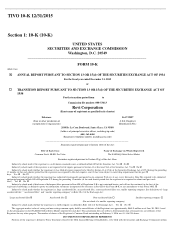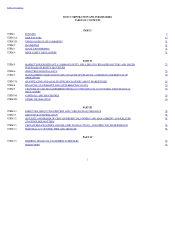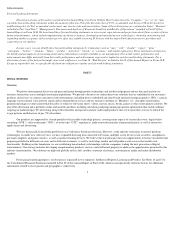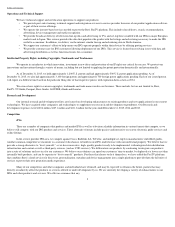TiVo 2015 Annual Report Download - page 5
Download and view the complete annual report
Please find page 5 of the 2015 TiVo annual report below. You can navigate through the pages in the report by either clicking on the pages listed below, or by using the keyword search tool below to find specific information within the annual report.
Table of Contents
Industry Background
The entertainment media marketplace is transforming as content moves from traditional broadcast distribution methods to internet protocol
delivery. Access to content and the overall entertainment experience is becoming distributed across many screens such as televisions, tablets, smartphones
and personal computers. This dramatic shift is impacting virtually every area of the entertainment industry: from content creation, aggregation and
distribution to consumer discovery, consumption and monetization. The expansion of network bandwidth, influx of connected devices and the increased
availability of digital content, along with increased accessibility through mobile devices such as tablets and smartphones are driving changes in consumer
behavior, accelerating the overall industry shift. As part of this change, consumers are demanding higher
-
quality and more personalized content
experiences, where they can easily discover and access entertainment content (movies, music, photos and programming), wherever and whenever they
want.
Video content, such as movies and TV shows, remains at the center of consumers' entertainment desires, accounting for the vast majority of
consumers' entertainment spending and consumption. While many consumers have purchased large high definition televisions (“
HDTVs
”
)
to maximize
video enjoyment in the home, new devices and services are now available which bring video content to consumers both inside and outside of the home.
These new devices and services require the ability to provide information to the viewer, identifying what is available across linear broadcast television,
DVR, or VOD, as well as internet services.
We refer to providing this information and associated services as “guidance.” Guidance becomes more complex as more sources of entertainment
become available to consumers. Setting up such an environment generally requires integrating numerous devices, a deep understanding of the
interoperability of media formats and creation of mechanisms for managing and enjoying content. Simplifying the consumer experience in these developing
media ecosystems is critical to the successful evolution of the industry.
The introduction of these new capabilities is impacting the entertainment value chain, from content producers to distributors, advertisers and
consumption device manufacturers, driving new business models, increasing competition among existing marketplace participants and introducing new
marketplace participants. Distributors such as pay TV providers, internet video services, retailers, and others are seeking ways to best obtain or maintain a
competitive advantage in this evolving digital entertainment world. The unprecedented variety of distributors requires highly customizable technology and
solutions which help to personalize and simplify the consumer experience, utilizing data about the entertainment content, the behavior of viewers and their
consumption patterns to drive advanced personalization and guidance, aimed at improving the user experience, while still allowing the distributor to retain
its unique brand and identity. Distributors are also seeking to increase their engagement, improve service and expand marketing to the consumer, creating
new or enhanced revenue opportunities across both broadcast and internet
-
based content. One area where the evolving distribution channel is most
prevalent is in cable and satellite, where there is a broad drive to enable subscribers to enjoy content where and when they want on whatever device they
use, which we refer to as "TV Everywhere" ("TVE"). TVE is driving investment as the service providers move from legacy distribution technology to
internet
-
based infrastructure for delivering pay TV services. Additionally, content producers are exploring new forms of distribution and business models
to protect and advance their position in the distribution value chain. Many content owners are trying direct
-
to
-
consumer business models, new forms of
content licensing and additional hybrid models that combine both traditional and pay TV with direct distribution. Conversely, some distributors are also
investing in original entertainment content to establish a more competitive position to protect their business from subscriber losses. Combined, these
changes are resulting in an overall increase in industry competition between distributors, leading to their need to invest and deploy differentiating services,
try new business models and be more creative in their approach to reaching, engaging and retaining the consumer.
The consumer electronics (“
CE
”
)
manufacturer industry is also in flux. Global economic trends and increased competition have challenged much of
the traditional CE device marketplace, driving margins lower while consumer requirements for features and content services increase. In addition to content
that is received over traditional broadcast on televisions and set
-
top boxes, consumers are demanding capabilities to interact with a broad range of media
and OTT video services. This increased functionality requires extensive software development, cloud infrastructure and ongoing maintenance and support
for these devices throughout their usable life, leading to much higher costs for a CE manufacturer for years after the initial sale to a consumer. These new
requirements may not be a core competency for CE manufacturers adding to the challenge of meeting consumer desires. Competing devices, such as
tablets, smartphones, game consoles and media streaming devices are also competing for consumer spending as consumers become more comfortable
managing multiple consumption endpoints. CE manufacturers are also seeking an ongoing revenue relationship with their customers, one that expands
beyond selling the consumer a new device every few years. This leads to a demand for add
-
on services and advertising that allow the
3


















